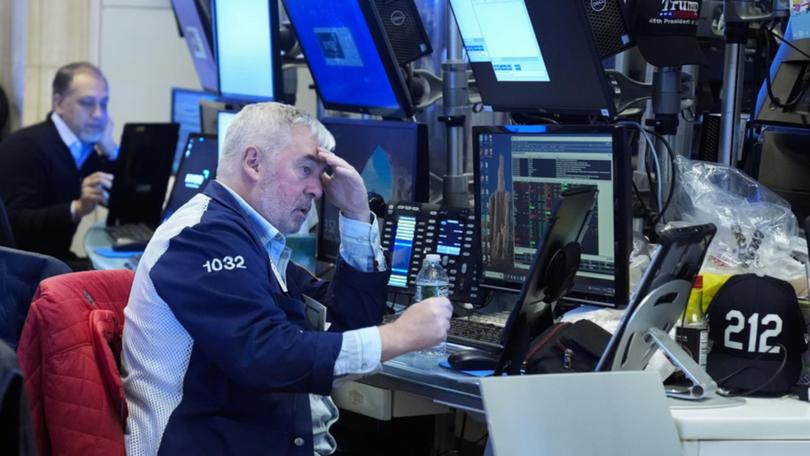Wall St ends mixed in face of mounting uncertainties

US stocks have struggled with the S&P 500 and the Nasdaq touching one-month lows as a dour consumer confidence report put mounting economic uncertainties into sharp relief and prompted a selloff.
The S&P 500 and the Nasdaq both notched their fourth consecutive sessions in the red, while the Dow ended the day modestly higher.
“This is clearly a risk-off day and a continuation of a risk-off month,” said Peter Tuz, president of Chase Investment Counsel in Charlottesville, Virginia.
Sign up to The Nightly's newsletters.
Get the first look at the digital newspaper, curated daily stories and breaking headlines delivered to your inbox.
By continuing you agree to our Terms and Privacy Policy.“Many companies are expressing caution about the direction of consumer spending at the moment and today’s consumer confidence number bears that out.”
The mood of the consumer, who props up about 70 per cent of US GDP, has dimmed considerably in February, according to The Conference Board’s consumer confidence index, which registered its steepest monthly drop since August 2021.
Rising consumer uncertainties were laid bare by an 11.3 per cent plunge in the near-term expectations component, well below the level associated with impending recession, suggesting Americans are growing anxious about the potential negative economic impact of the policies of President Donald Trump’s administration.
Tuz said the political environment was not helping.
“Headlines have been pretty dramatic ... and as a result consumers and maybe businesses are sitting on their hands to see how things shake out before making major purchasing decisions or other business decisions,” Tuz said.
“There are just lots of reasons to put off buying things today, including stocks.”
Richmond Federal Reserve President Tom Barkin said on Tuesday that current uncertainties call for a measured, cautious approach to monetary policy.
Interest-rate futures imply the US Federal Reserve will hold its key interest rate steady for the first half of the year, according to data compiled by LSEG.
The CBOE market volatility index, widely known as the “fear index”, spiked to its highest level since January 27.
Bitcoin, often viewed as a barometer of investor risk appetite, dropped 6.1 per cent.
The Dow Jones Industrial Average rose 159.95 points, or 0.37 per cent, to 43,621.16 on Tuesday, the S&P 500 lost 28.00 points, or 0.47 per cent, to 5,955.25 and the Nasdaq Composite lost 260.54 points, or 1.35 per cent, to 19,026.39.
Among the 11 major sectors in the S&P 500, communication services fell the most, with consumer staples enjoying the biggest percentage gains.
Nvidia dropped 2.8 per cent ahead of the chipmaker’s much-anticipated quarterly earnings report, expected after the bell on Wednesday, pulling the Philadelphia SE Semiconductor index down 2.3 per cent.
US officials, in a bid to restrict Beijing’s technological capabilities, are aiming to restrict the quantity and types of Nvidia chips that can be exported to China without a licence, according to a Bloomberg report.
Bitcoin weakness weighed on crypto stocks. Coinbase and MicroStrategy dropped 6.4 per cent and 11.4 per cent, respectively.
Zoom Communications slid 8.5 per cent following its disappointing annual revenue forecast.
US-listed shares of Li Auto jumped 13.2 per cent after the company unveiled its first electric SUV.
Eli Lilly rose 2.3 per cent after the drugmaker said it has begun selling higher doses of its weight-loss drug Zepbound in vials in the US, at a discount to the injector-pen versions.
Solventum jumped 9.5 per cent after drug manufacturer Thermo Fisher said it will buy the company’s purification and filtration business for about $4.1 billion.
Advancing issues outnumbered decliners by a 1.2-to-1 ratio on the New York Stock Exchange. There were 89 new highs and 163 new lows on the NYSE.
On the Nasdaq, 1,720 stocks rose and 2,714 fell as declining issues outnumbered advancers by a 1.58-to-1 ratio.
The S&P 500 posted 31 new 52-week highs and eight new lows while the Nasdaq Composite recorded 44 new highs and 305 new lows.
Volume on US exchanges was 16.32 billion shares, compared with the 15.32 billion average for the full session over the last 20 trading days.
